
Lightning
How many types of lightning are there, and how did the Victorians perceive and rationalise them? This article by James Broome, first published on The Strand Magazine in 1897, puts together photographs from both observatories and amateurs to show lightning in many of its different forms and shapes, while reflecting on its power and the damage it leaves along the way.
Lightning dearly loves a tortuous path. Sometimes, of course, it does goes straight to business and does not stop on the way, but, in the majority of cases, it meanders about the empyrean, curls itself up in a lot of knots, shoots out in flashing filaments, and when it gets tired of roaming, comes down to visit the gas-pipes and stir things up generally.
It is a brilliant visitor, but modest people usually avoid it–or try to. In fact, some people put spikes up to ward it off, but there have been cases where even this pointed rebuke has failed. Be that as it may. In this article we are not concerned with lightning-rods, but with the lightning flash and the ruin it leaves behind.
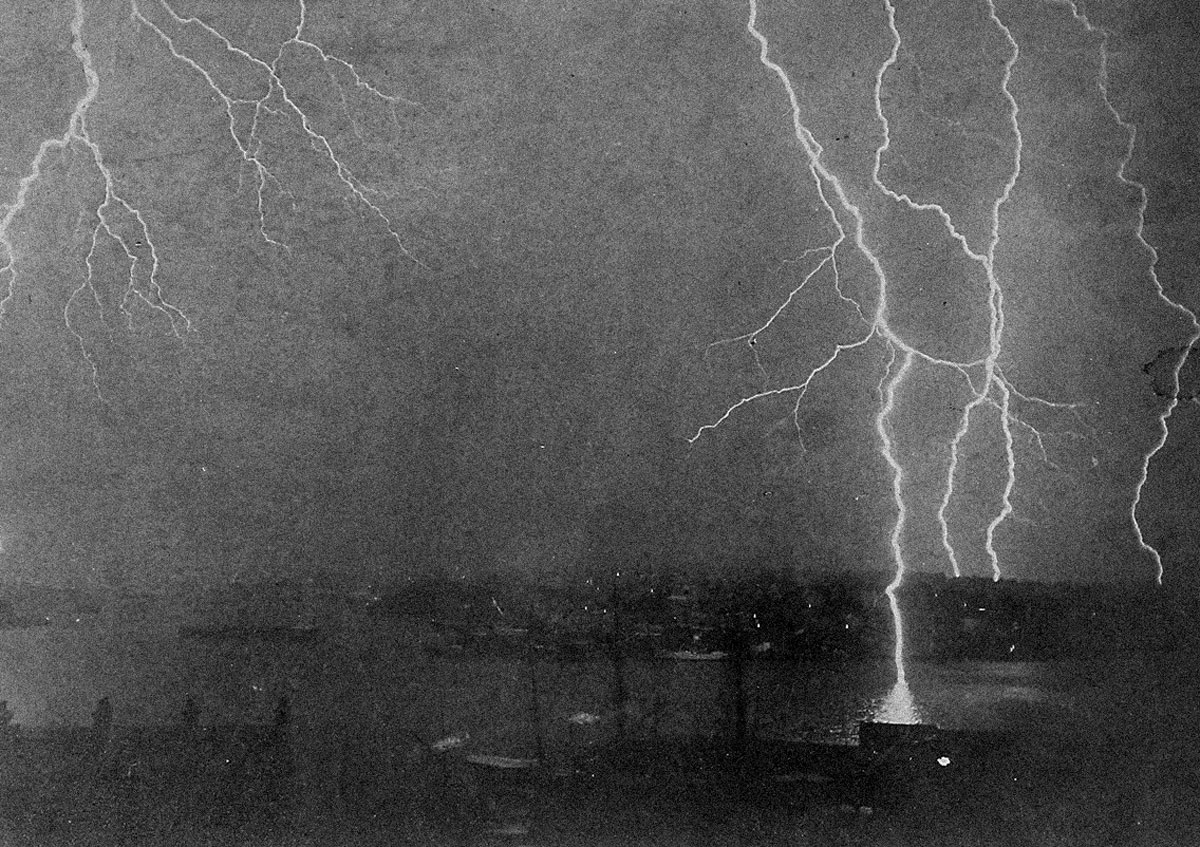
Fig 2. Ramified lightning at Sydney, N.S.W., Dec 7, 1892. Top image: Fig. 1. Stream lightning at Dubuque, Iowa, U.S.A., July 17, 1887.
To illustrate it, we have an almost unprecedented collection of photographs, We have pictures of tall oaks laid low, stone walls shattered, trousers demolished, and boots in frightful collapse. And, to crown it all, we have a photograph of a thunderbolt that wasn’t a thunderbolt, and a picture of zigzag lightning, the like of which was never seen.
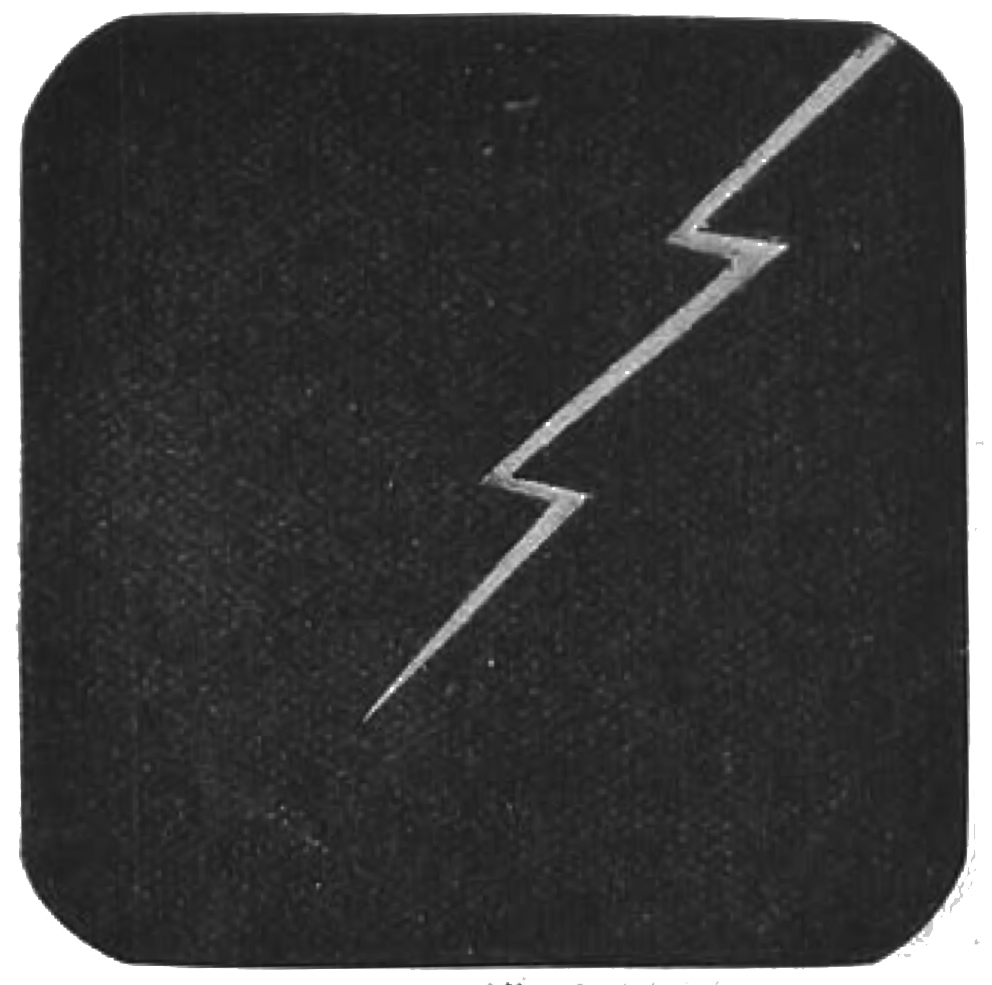


Left to right: Fig. 3. “Artists” Lightning.
Fig. 4. Ribbon Lightning.
Fig. 5. Triple flash of meandering lightning.
Let us attend to this zigzag lightning. From time immemorial it has been the custom of artists to depict lightning in the jagged form shown by our reproduction (3). But the artists have all been wrong. Out of the thousands of photographs that amateurs and professionals have taken, there has never been a case of a zigzag flash, and it must now be admitted that Nature never works in such a crooked way.
The great Turner was the first to paint lighting as it really is, and in one of his famous landscapes we find a simple thread of light in the midst of the gathering clouds. Nasmyth, the inventor, in 1856, contributed a notable paper to the British Association, and gave scientific support to the accuracy of Turner’s observation. Yet some artists still use the zigzag flash, and delight therein.
There are several distinct kinds of lightning, and most of these are illustrated by our photographs. In order, however, to show immediately the great contrast between the various forms, we avoid following, for the moment, the order in which the pictures are arranged, and refer to them only by their numbers.
Number 4, for instance, lent to us by Mr. Shelford Bidwell, F.R.S., is an excellent specimen of “ribbon lightning” ; (5) is a triple flash of “meandering lightning,” in which “knots” are distinctly seen; (7) is also an excellent specimen of “meandering lightning.” It was taken in Newark, New Jersey, the camera beingforty-nine feet from the telegraph-pole, which the lightning touched.

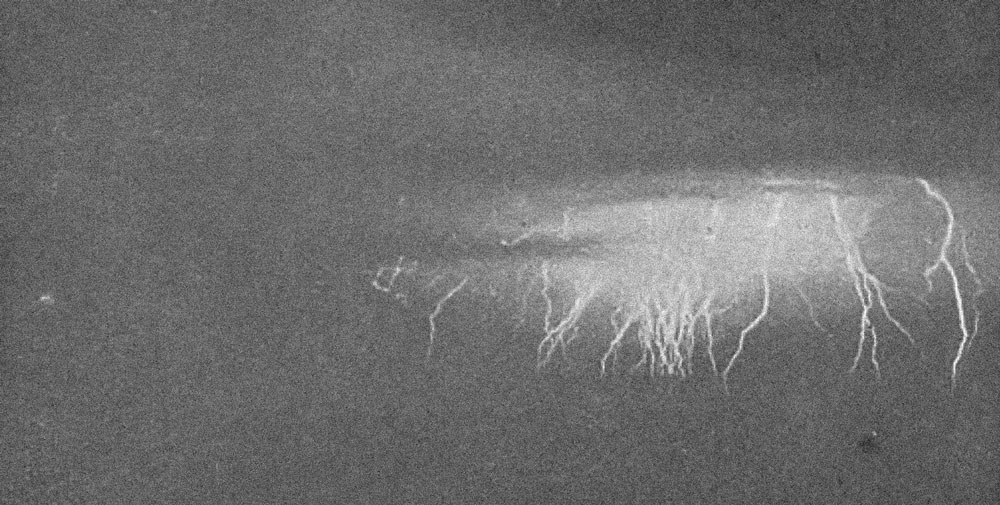
From left to right: Fig. 7. Meandering lightning striking a telegraph pole, Newark, New Jersey, U.S.A.
Fig. 6. Sinuous lighting, with ramifications
The Sydney photo. (2), which we mention later, gives a fine idea of the “ramified lightning,” in which the small flashes are attached to the main flashes, as fibres are to the roots of trees. A like effect is shown in (6), which is more properly called “sinuous” lightning, as most of the flashes keep the same general direction, though bending irregularly from side to side; (8) shows the ramified flash.
One of the most remarkable flashes ever photographed is shown in (2). It was taken at Sydney Obseryatory on December 7th, 1892. The flash on to the water was 1,540ft. long, and was not all taken, the upper part being above the limit of the camera. The point at which it struck was 2,000ft. from the camera, and the camera was 160ft. above the water.
How well the photograph shows the sleeping town! Yet the night was pitch dark, except for the brilliancy of the lightning, and the plate was so good that it shows even the lights of the street-lamps.
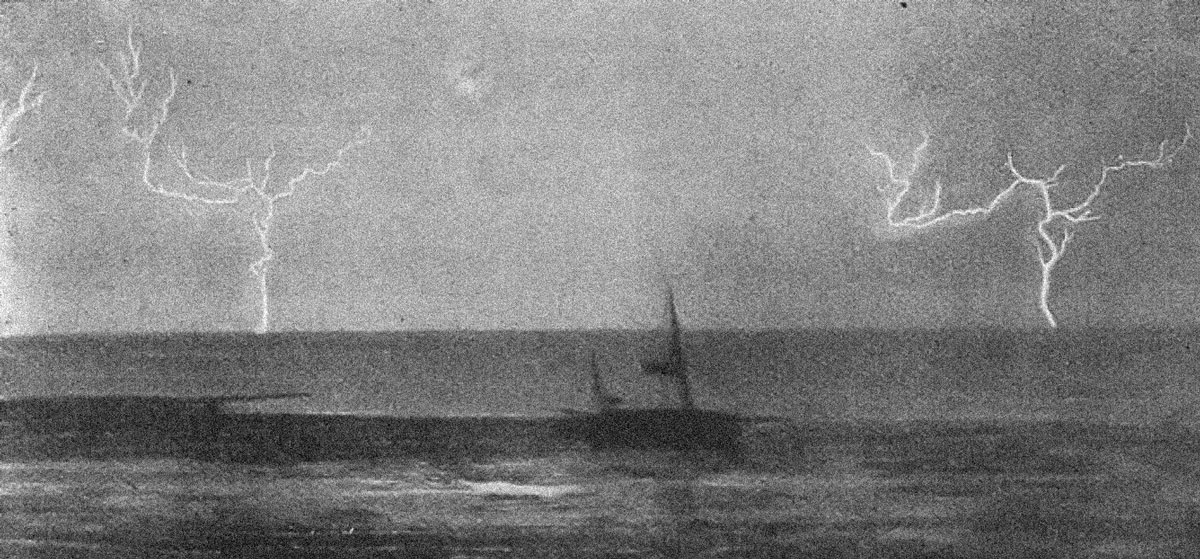
Fig. 8. Ramified lightning
As a further illustration of the different forms, we reproduce three striking photographs with characters all their own. The first (9) is distinctly ramified, and its seeming connection with the steamship makes it marvellously attractive. But, so far as we know, the flash may have been miles and miles beyond the ship.
The next photo. (10) shows “stream” lightning near Trinity College, Cambridge, about midnight of June 6th, 1889. The flash appears to descend directly upon the buildings in the background. The Dubuque, Iowa, photograph (1), shows a curiously-formed flash seen at 10 p.m. on July 17th, 1887. It needs but a mouth and an eye to make it a perfect profile on the sky.
The subject of “lightning prints” has, for many years, occupied the attention of scientists, It was first brought to the notice of the public by Professor Andreas Poey, of Havana, who, in a small pamphlet, published in 1861, cited some two-score cases, in which lightning had photographed objects upon the human skin.


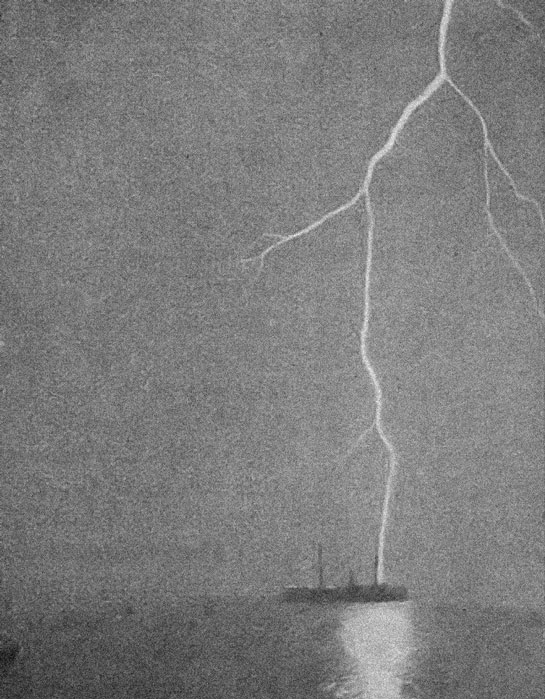
Left to right: Fig. 10. Stream lightning behind Trinity College, Cambrige.
Fig. 11. Arborescent marks on boy’s arm, Duns, N.B.
Fig. 9. Ramified lightning behind a steam ship.
In 1825, it was said, a sailor, who had been mending his shirt at the foot of a mast, was struck by lightning, and when the dead body was undressed, the image of a horse-shoe was distinctly visible upon the small of the back—an exact representation, in short, of a horse-shoe nailed to the ship’s mast.
Another sailor, struck in the same manner, had the name of his ship plainly marked upon his breast. Trees, birds, cows, crosses, and other objects have been photographed in like manner, so it is said. At Errol, a few years ago, the picture of a roof of a house was reported to have been seen on an insulator.
But the most remarkable story of all has been written about six sheep killed by lightning about four miles from Bath, in 1812. When the skins of the sheep were taken off, “a fac-simile of a portion of the surrounding scenery was visible on the inner surface of each skin.”
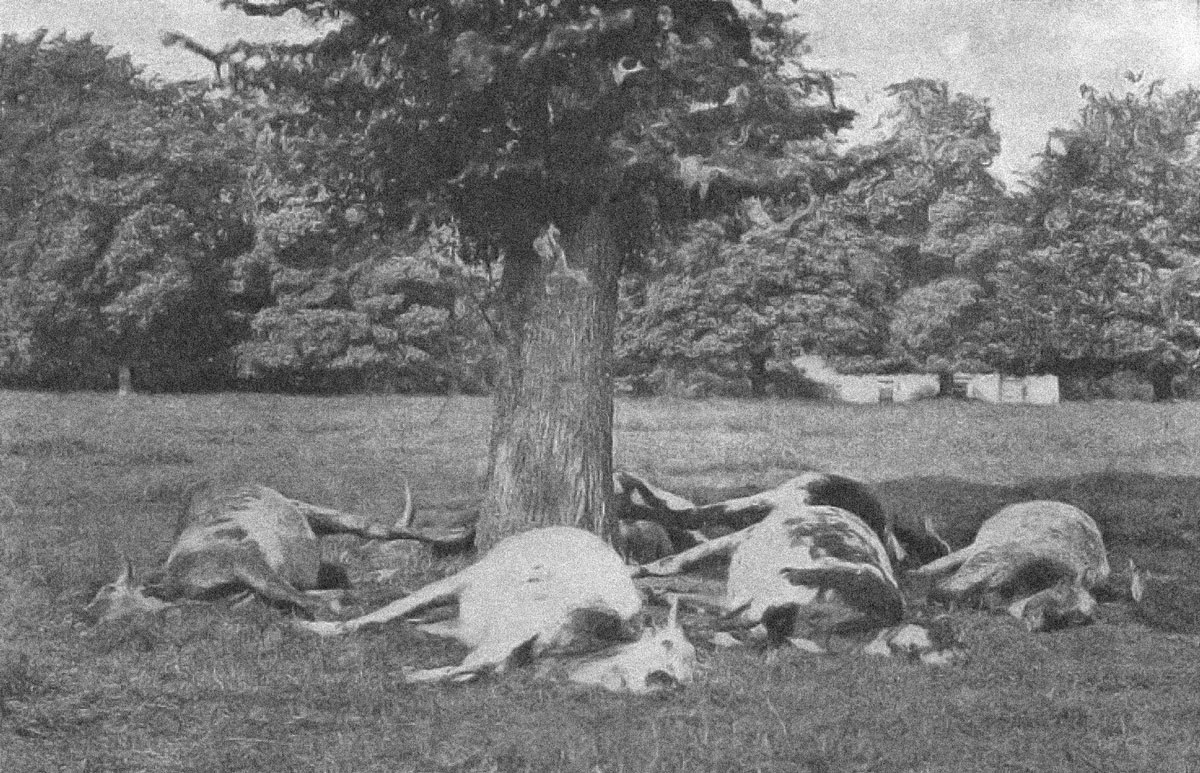
Fig. 14. Cattle killed by lightning near Bury St. Edmonds.
Of these remarkable occurrences, However, there have been no photographs. Indeed, the only photograph of a lightning print which has been published is probably that reproduced herewith (11). It represents the arm of a boy who was standing by a yew-tree at Duns, in Berwickshire, on June 9th, 1883.
When the tree was struck the boy was thrown across the road, and upon examination, he was found to have the “impression of the yew-tree branches” distinctly marked upon his skin.
The beautiful fern-like figure would certainly tempt one to believe that the tree had been photographed upon the flesh, but the phenomena is probably due simply to the ramifications of the electric fluid, such as may be seen on a sheet of deflagrated gold-leaf. If this is true, people have been tricked for a century by these reports of “lightning prints.”


From left to right: Fig. 15. Oak shattered by lightning at Ewhurst Church, Surrey.
Fig. 16. Walnut tree struck by lightning at Feltwell, Norfolk.
The effect of lightning on wearing apparel is most curious. A glance at our reproduction (12) will show that when a flash once gets on terms of familiarity with a suit of clothes, it leaves nothing to speak of.
The photograph was taken by W. Marriott, Secretary of the Royal Meteorological Society, after a thunderstorm, which passed over the Spaniard’s Farm, Hampstead Heath, on June 14th, 1888. Two workmen were eating dinner under a tree when the flash came, rendering one senseless and stunning the other.
The stunned man felt no pain, but discovered that his trousers were burning, that his knife had been knocked out of his hand, and that his steel buckles had been torn from his legs. When he had put the fire out in what was left of his trousers, he managed to crawl to the road for assistance. The first man had burns on his right side from shoulder to foot.

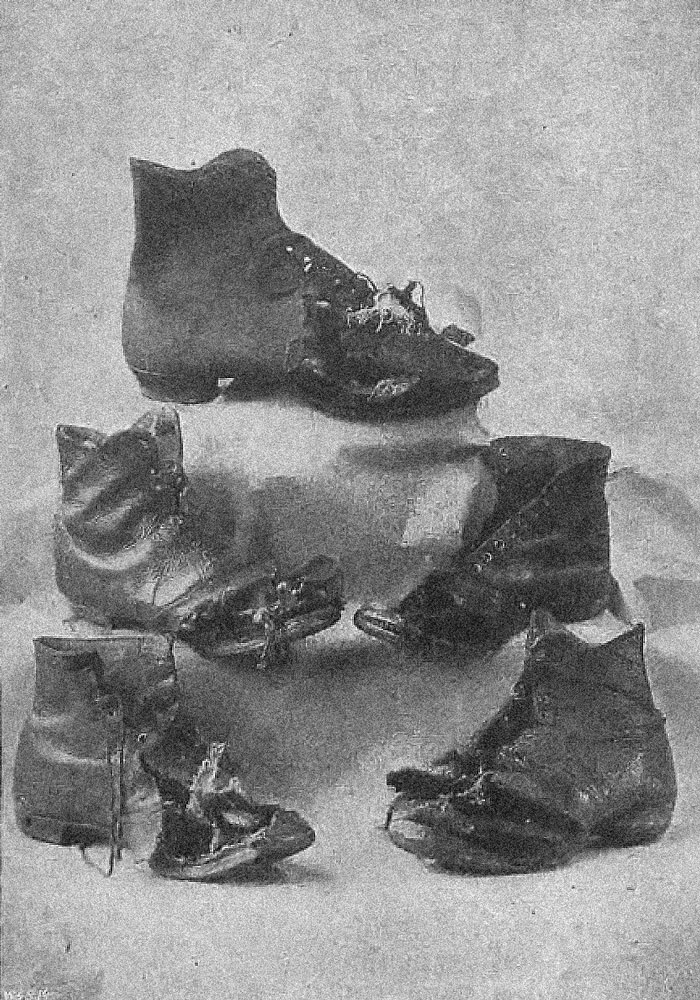
From left to right: Fig. 17. Oak struck by lightning on two successive days near Cranley, Surrey.
Fig. 13. Choristers’ boots burnt by lightning at Atcham Church, Shrewsbury.
It is difficult to account for the disruptive effect that lightning has upon clothes, but it is supposed that the current travels along the damp surface of the skin, driving the moisture into vapour, which, on account of its expansion, blows the clothes to tatters.
The boots shown in (13) were doubtless burst by this means. They belong to some very respectable choir boys in Atcham Church, Shrewsbury, which, in July, 1879, was visited by lightning.
It may be said, in passing, that the clothes of women are much less likely to be shattered by lightnirg than the clothes of men. Feminine apparel is loose, whereas the comparative tightness of masculine attire, and the greater tendency to perspiration, offer excellent opportunity for the explosion of expanded vapour.
To show the deadly effect of a lightning flash, we reproduce a photograph (14) sent to us by Herman Biddell, Esq., of Playford, Ipswich. Mr. Biddell writes that the beasts were found lying under a tree near Bury St. Edmunds, and in an interesting paragraph says, àpropos of damage to trees:
“I fancy the pulverization of the bark of a tree full of sap is the effect of the moisture being instantly converted into steam. I do not think we have any conception of the heat generated by the electric fluid being brought into contact with non – conducting matter. Dead trees are never struck by lightning; at least, I never yet saw one.”
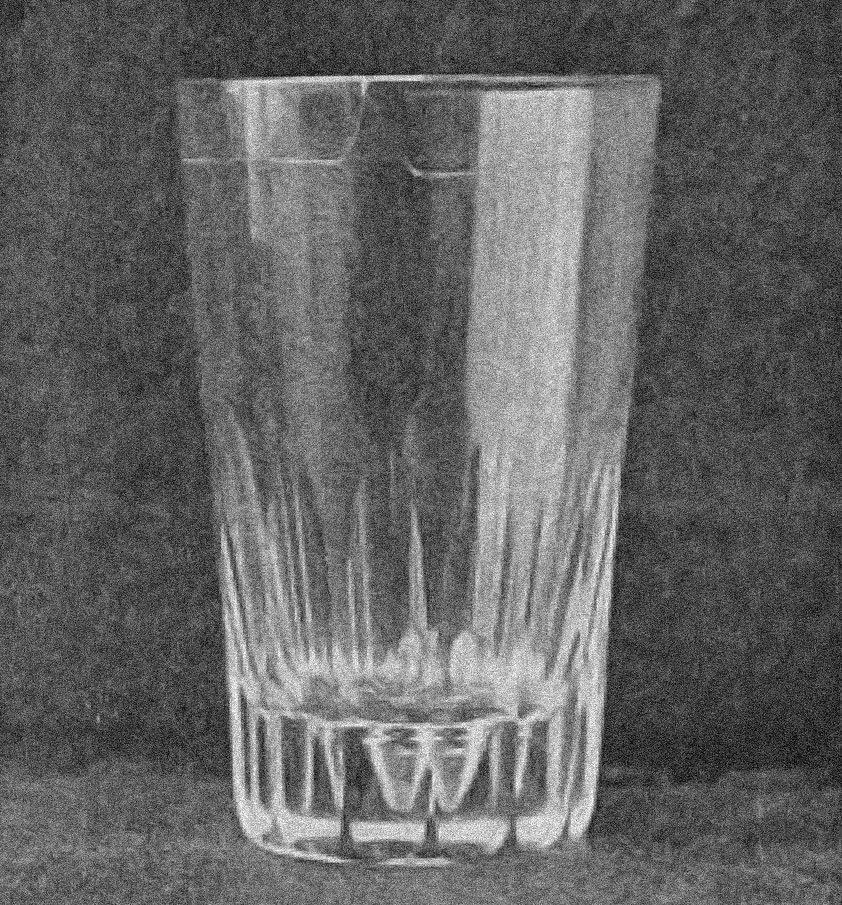
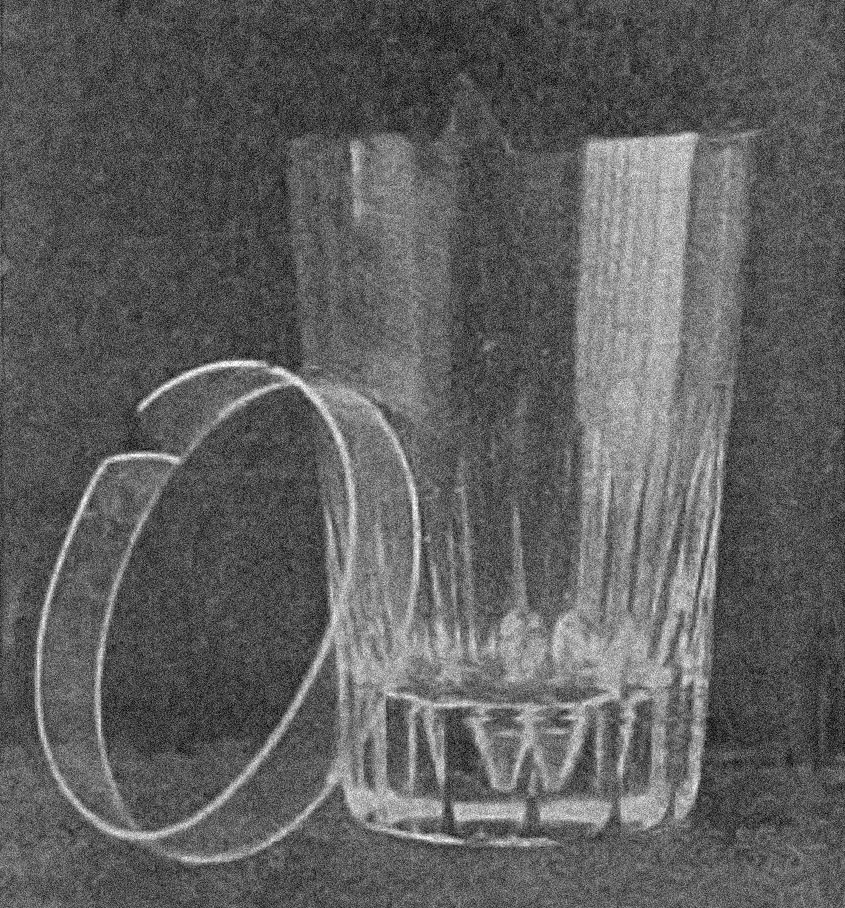
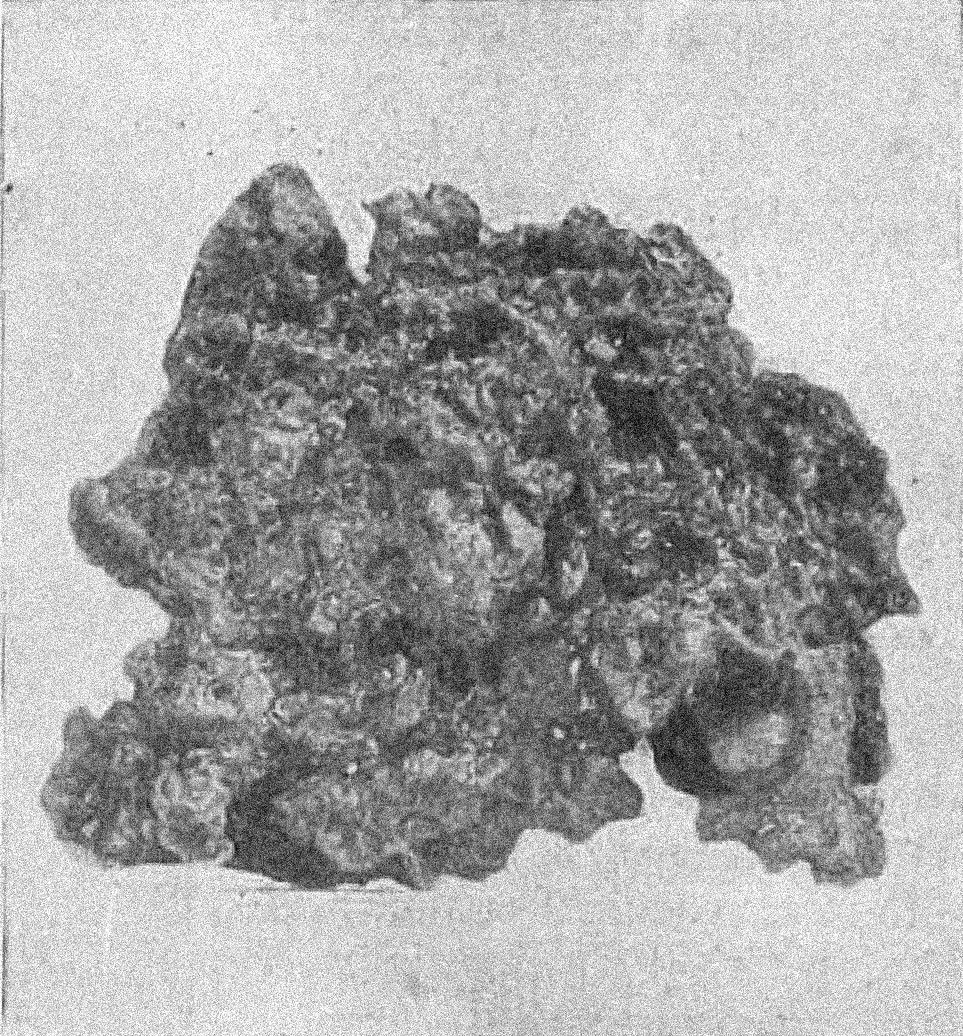
Left and middle: Fig. 21 & 22. Curious fracture of a glass tumbler at Leatherhead.
Right: Fig. 20. The Kilburn Thunderbolt, July 5, 1877.
The tree in (14), it may be noticed, was little harmed, although the poor beasts under it were killed. In (15) we note the effect upon the tree. This oak was struck at 2 p.m., on April 27th, 1895, a quarter of a mile west of Ewhurst Church, Surrey, It sometimes happens that a tree gets off with a scar, or with the loss of a little bark. But in the case of oaks and elms, of which lightning is particularly amorous, the damage is often enormous.
Elm, chestnut, oak, and pine are often struck; ash rarely; beech, birch, and maple never. At least, so wrote once a scientist, Mr. Hugh Maxwell, to the American Academy in 1787.
On the evening of September 12th, 1896, during a violent thunderstorm, a large walnut tree in full leaf, in the village of Feltwell, in Norfolk, was struck by lightning and set on fire.
The tree blazed most of the night, in spite of heavy rain, until the trunk, which was partly hollow, the tree being an old one, split open, and the next morning the tree presented the appearance shown in the photograph (16). A hen which had been under the tree was killed, but some of her chickens escaped with their feathers on fire.
Lightning, so runs the old saying, never strikes twice in the “same place, but, like a bought affidavit, the statement is false, Not only does it sometimes strike twice, but it finishes things up when it comes the second time, as witness the oak in (17). This splendid tree was first struck on June 6th, 1889, at 5.30 p.m., and the next day at half-past one it was shivered and split open. The ruin stands on Old Farm, Rachel Court, four miles from Cranleigh, Surrey.
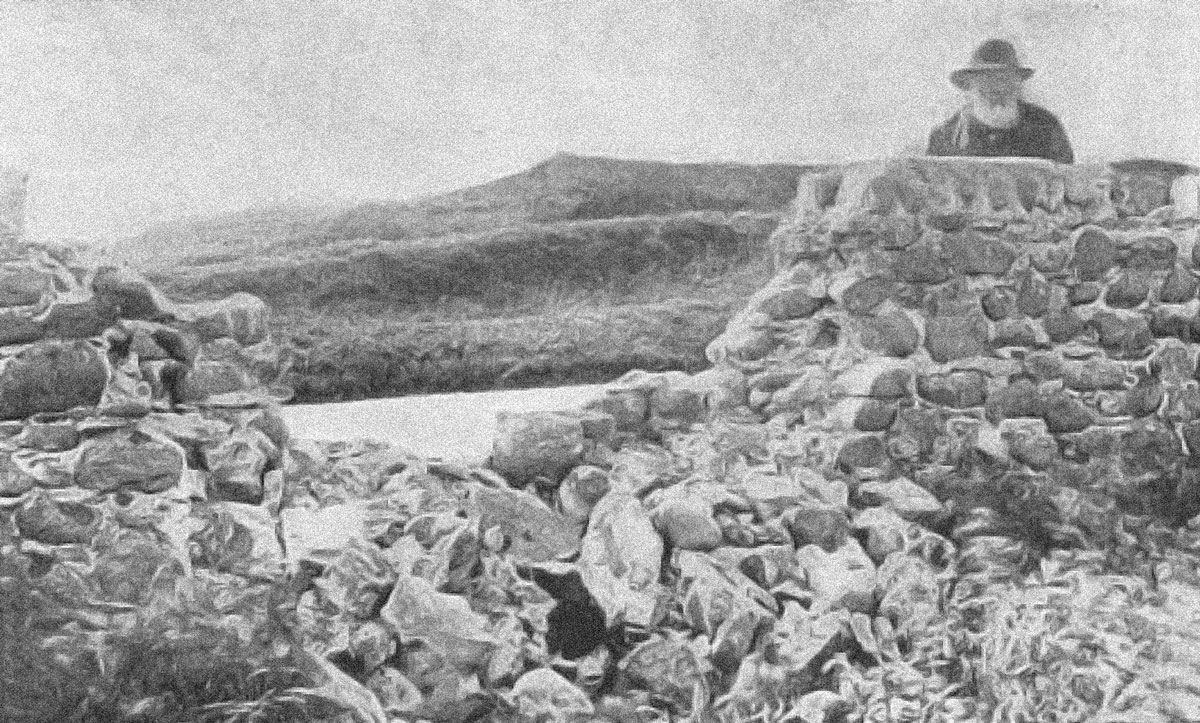
Fig. 19. Stone wall broken by lightning at Allonby, Cumberland.
More picturesque than (17) is the ruin shown in (18). The trunk of this tree was ruptured from top to bottom in a series of twisted splits. In this case, the sap of the tree was probably converted into vapour, with the explosive result. The accident occurred at Thornbury, Gloucestershire, July 22nd, 1891. The tree was an oak.
The accompanying reproduction (19) shows the damage done to a stone wall on Cop Hill, Allonby, Cumberland, ‘The thunderstorm took place on May 31st, 1894, and the benevolent – looking gentleman standing behind the ruins is Mr. Clark, aged eighty-four. The photograph was lent by G. J. Symons, Esq., who obtained it from Mr. Clark’s son.
Professor Tyndall used to tell a story of a lady who, shutting a window casement during a storm, had the gold bracelet on her arm deflagrated by a flash, which left her perfectly unhurt, but with a blue mark around her wrist. The blue mark was oxide of gold—all that was left of the bracelet. Another lady had her bonnet burnt, the wire frame having attracted the lightning, but the wearer was unhurt.
Now comes the “thunderbolt”—that is to say, part of it. It “fell” on July 5th, 1877, at Kilburn, and was picked up by James Parbett, of the Kilburn Fire Station, when it —the thunderbolt — was cold. “Three peals of thunder,” says a newspaper account, “were heard in quick succession, and with the last a sheet of fire seemed to fall into Bridge Street.” (Mark that “seemed.”)


From left to right: Fig. 18. Clothes of men injured by lightning at Hampstead Heath, June 14, 1888
Fig. 23. Lightning-rod destroyed by fusion.
“The thoroughfare,” continues the account, “seemed to be completely in flames, and a material similar to molten metal descended, which, on reaching the ground, coagulated, leaving behind clinkers from an inch to six or seven inches in circumference.” Our picture (29) shows one of these pieces; but how like an ordinary domestic clinker it looks!
Well, it is a clinker, and fell from one of the fire-engines engaged in putting out the great Kilburn conflagration. The “molten metal” which “descended” was probably a bit of telegraph wire broken and fused by the flash. At least, this is the conclusion of a noted scientist who has a passion for hunting “thunderbolts” down.
Through the kindness of Abraham Dixon, Esq., of Cherkley Court, Letherhead, we are able to show the astonishing result of a lightning flash, which occurred in his gardener’s house during a storm on September 7th, 1895. The tumbler (21) was struck, causing a fracture of a perfectly annular character, interrupted only by the triangularly shaped crack shown in (22).
So neatly was the glass cracked that the ring (which was about half an inch in width) could be lifted from the tumbler and replaced with a perfect fit. After the storm was over, it was found in place, although perfectly detached.
Fusion is one ef the catastrophes that sometimes happen to poorly-made lightning-rods, sometimes on account of poor material, and frequently on account of unequal resistances offered by different portions of the rod.
Our reproduction (23) shows portions of a conductor, fused at Upwood Gorse, Caterham, on May 28th, 1879. The circular rod was fused at the screwed union, as shown, The plaited copper-wire failed, probably on account of a bad joint with the circular rod.
Recent articles

Southern California is many things. Quite infamously, it is known as a landscape defined by the automobile, from the emergence and diffusion of the highway system to fast food burgers, and the suburbanization of the United States. Walking this place then, would seem not only inconvenient, but ill advised. In… Read more »

What is today known as ‘whistleblowing’ could once take the form of interacting with a threatening gaze carved into the city wall. It is the case of the ‘boche de Leon’ or ‘lion’s mouths’ disseminated by the old Venetian Republic throughout its territory to suppress illegal activities. Through a close… Read more »

As he navigates through the recurrent lockdowns of the pandemic, stranded between hitchiking and muggings, job hunting and separations, Fabio Valerio Tibollo rediscovers photography as a powerful coping mechanism. Recording everything that happened around him for one year straight, from attending momentous events to finding curiosity in shots of simple living,… Read more »

